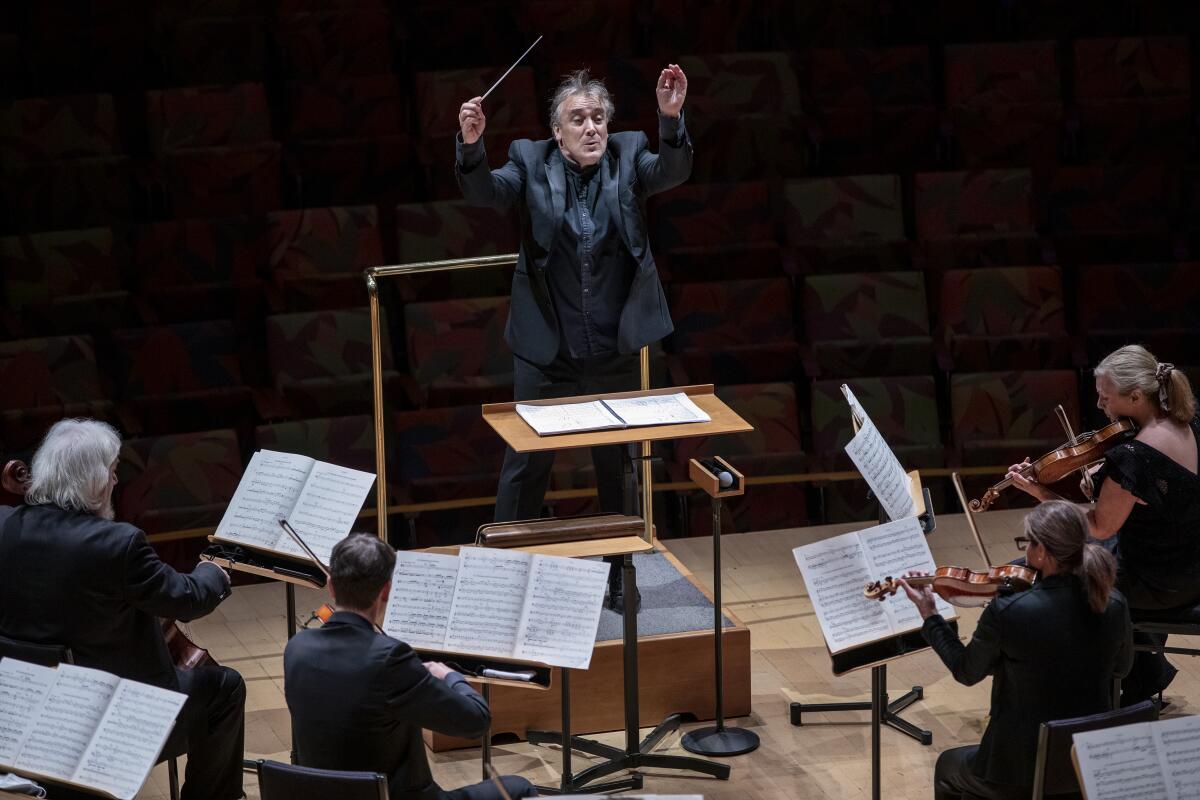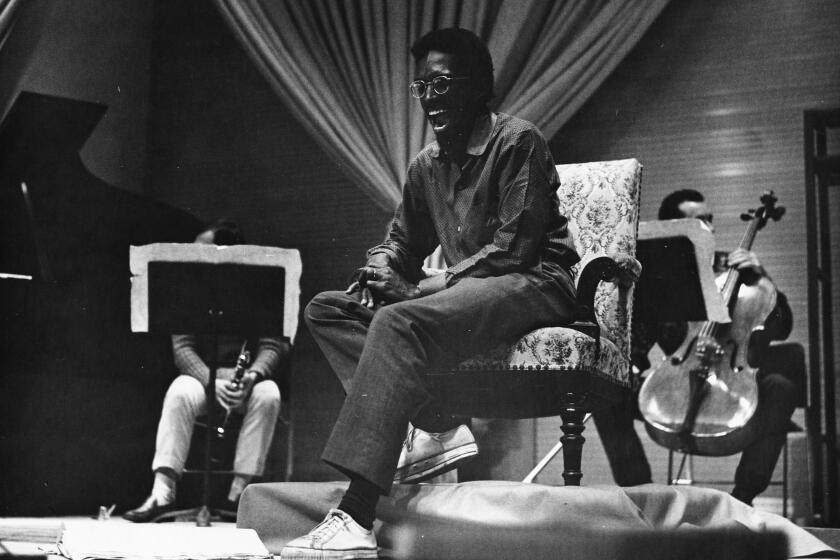Review: Disney Hall breathes back to life, courtesy of Los Angeles Chamber Orchestra

- Share via
The last music heard in Walt Disney Concert Hall before the pandemic shutdown was pianist Conrad Tao’s performance of Frederic Rzewski’s “The People United Will Never Be Defeated,” part of the Los Angeles Philharmonic’s Power to the People! festival.
Well, we didn’t remain exactly united in the 474 days (if I count correctly) until live music was heard again in Disney Hall on Saturday night. But we did, in ways thrilling and chilling, explosively fuel people power in those months.
The first notes heard again in the long-quieted Disney were a slow, soft upward harp arpeggio, each pitch a haunting, crystalline moment ringing in the air as a harp will in the hall’s illuminating acoustic, stopping a listener’s breath and time along with it — each note an eerie resonance to remember.
The program was not by the L.A. Phil but the Los Angeles Chamber Orchestra, its regular halls at UCLA and in Glendale still dark. The opening piece was Ginastera’s “Variaciones Concertantes.” The eeriness was due to a seemingly supernatural twist of fate.
Rzewski’s politically provocative set of variations, one of the most important major piano scores of the last half century, was based on a Chilean protest song. Ginastera’s 1953 chamber orchestra “Variaciones” was written when the Argentine composer was having his own political clashes with his country’s dictator, Juan Perón. On Saturday, just hours before the LACO concert, Rzewski died of heart failure at 83. Those ethereal first six ascending harp pitches, derived from the guitar’s open strings, became his uncanny sendoff.
There was no mention made of Rzewski. The concert was a celebration, not a memorial. We have been returning to concert life in Los Angeles gingerly. First with the L.A. Phil in a weighty program at the Hollywood Bowl, then with Los Angeles Opera’s plague-heavy “Oedipus Rex” in the Dorothy Chandler Pavilion. In both cases masks stayed on for the audience. It was not yet time to breathe an uncaring sigh of pandemic release.
It still may not be, but much had changed even in the three weeks since “Oedipus” across the street. Proof of vaccine was still required, and county regulations continue to restrict audience size to around one-third capacity. But when concertmaster Margaret Batjer came onstage to tune the orchestra, she triumphantly threw off her mask. The masked players triumphantly threw theirs. Jaime Martín, the orchestra’s Spanish music director whose contract has just been extended until 2027, came out as vivacious as a victorious bullfighter. The audience by that time was mostly maskless and delirious as well.
To follow all that not with a splash but the awe of a harp’s serene sonic splendor was a moment of genius. Ginastera’s score catches fire soon enough. A tender theme in solo cello leads to a series of colorful variations that show off the virtuosity for solo instruments. It ends in gratifying dance.
Coronavirus may have silenced our symphony halls, taking away the essential communal experience of the concert as we know it, but The Times invites you to join us on a different kind of shared journey: a new series on listening.
The rest was all happy music. The young Mexican composer Juan Pablo Contreras made a new chamber orchestra version of his best-known piece, “Mariachitlán” (Mariachi Land), written in 2016, while he was a student at USC. A 10-minute mariachi mix, tunes broken up and played together, begins as a kind of Guadalajara take on Ives’ evocation of colliding marching bands but remains more conventional, even slightly Hollywood at the end. A bland two-piano arrangement was streamed in January in LACO’s Close Quarters video series. The new orchestration brings the score to splendid life.
The concert — no intermission, program notes read on the phone rather than in print — ended with Mendelssohn’s brightest symphony, his Fourth (“Italian”). It, and all that came before, was a parade of exuberance, a kind of aural psychotropic medicine, dispensed by Doc Martín, to lift moods. It worked with what appeared to be 100% efficacy.
This was particularly striking, given the moody visual tone of LACO’s video pandemic offerings directed by James Darrah and the unnerving sight of musicians performing in their individual safety-glass cages. In contrast, Saturday was an evening of freedom. Solos in the Ginastera said in every case, “I’m back in my glory.”
“I cannot tell you how happy I am to be here,” Martín told the audience at the end of the happy Mendelssohn. By that point, the line almost sounded redundant. All evening, Martín had conducted as though a hungry musician at a gourmet feast, every phrase a morsel to shared and savored. LACO, sounding more alive than ever in Disney, made an irresistible case for a great acoustic space of its own, as will be the case if and when the Colburn School builds its proposed Frank Gehry-designed concert halls, with acoustics by Yasuhisa Toyota, across Grand Avenue.
Meanwhile, Martín’s winning ways have been catching on quickly in three continents. Along with his LACO post, he is principal conductor of the RTÉ National Symphony Orchestra of Ireland. Next year he adds the Melbourne Symphony Orchestra. I hope he likes air travel as much as he does letting a lyrical line take flight.
Saturday’s concert, broadcast Monday night on KUSC, remains archived for a week. LACO will stream it in July along with a program Martín and the orchestra will play at the Huntington Library on Thursday.
The sad but important story of neglected minimalist Julius Eastman is reaching new audiences courtesy of Wild Up, L.A. Phil and N.Y. Phil.
More to Read
The biggest entertainment stories
Get our big stories about Hollywood, film, television, music, arts, culture and more right in your inbox as soon as they publish.
You may occasionally receive promotional content from the Los Angeles Times.













